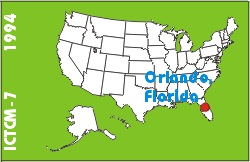
Electronic Proceedings of the Seventh Annual International Conference on Technology in Collegiate MathematicsOrlando, Florida, November 17-20, 1994Paper C030Families of Linear Functions and Their Envelopes |
Steve LighDepartment of Mathematics Southeastern Louisiana University Hammond, LA 70402 USA Phone: (504) 549-2175 LIGH@SELU.EDU list of all papers by this author | Randall G. WillsDepartment of Mathematics Southeastern Louisiana University Hammond, LA 70402 USA Phone: (504) 549-2660 rwills@selu.edu list of all papers by this author |
| Click to access this paper: |
Additional file(s) associated with this paper:
|
ABSTRACT
The topic of envelopes of families of curves was present in calculus texts forty years ago, but has since been deleted. With the advent of computer algebra systems such as Maple, Mathematica, and Derive, this topic is accessible to our calculus students and is a good example of the type of problem where the computer can be used as a tool to aid in the solution of a problem. The purpose of this note is to introduce envelopes of families of lines, to study some of the geometric properties of envelopes, and finally to present a closed form expression of the envelope. We have used Maple V to generate pictures of various families of lines and have used these pictures to help us make conjectures about the corresponding envelope.Consider the family of lines y=a*x+f(a), generated by a differentiable function y=f(x). We define the envelope of this set of lines to be a function y=g(x) such that every line in the family is tangent to the graph of y=g(x) at some point and through each point on the graph of y=g(x), there passes a line in the family that is tangent to y=g(x). We use the notation f(x)->g(x) to denote that the envelope of the family of lines y=a*x+f(a) is the function y=g(x). We present two main results:
Theorem 1 will describe the effect that translations and dilations of f(x) have on the envelope g(x), and Theorem 2 will give a closed form expression for the envelope g(x) for a certain class of functions f(x).
Theorem 1: Suppose f(x)->g(x), and let F(x)=A*f(B*x+C)+D*x+E, and G(x)=A*g(x/(A*B)+D/(A*B))-(C/B)*x+(-(C*D)/B+E) where A, B, C, D, E are real numbers and A,B<>0. Then F(x)->G(x).
Theorem 2: Suppose f(x) is a differentiable function such that f'(x) is injective. f(x)->g(x) if and only if g(x)=f((f')^(-1)(-x))+x*(f')^(-1)(-x). Note: (f')^(-1)(x) is the inverse of f'(x).
